Firstly there is the prompt radiation, both neutrons and gamma rays. The term prompt means that the radiation is emitted while the bomb is exploding, and the fission reactions are occurring. This phase is extremely short, at around a few nanoseconds.
The radiation emitted after that is the “delayed” radiation, which is produces as the device is expanding into a fireball. The exploding gas is a lot less dense than the bomb (the bomb was a solid, now it’s a gas…) and is large and extended. Reactions are continuing in this time, as fission products decay and emit both neutron and gamma radiation. The radiation is technically referred to as delayed, but it is emitted during a period of a few seconds. If you happen to be safe behind a supercomputer in a lab, the distinction between “prompt” and “delayed” might be interesting, here we can include these two together and call them the “initial” radiation. Basically, the initial radiation is the radiation from the weapon.
The third phase, which is more difficult to study, is when the bomb begins to interact with what ever it is touching, such as sucking up dirt to make fallout, or the gas bubble from an underwater explosion. Here the neutrons are irradiating the surrounding material, making them radioactive, and this is then dispersed around the place. During the first phases of the detonation, the blast wave can carry radioactive material along the ground, and could cover the survivors with dust. Fallout will also be produced from vaporized weapon components and bits of the ground and surrounding that are irradiated and sucked up into the atmosphere. Let me add again: This article has nothing to say about fallout. It is about the initial, rapid radiation that more or less cannot be avoided for someone in the open.
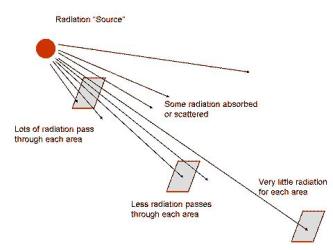
Figure 1 Falloff of radiation in simple terms. Two things can affect the radiation falloff from a source. As the distance increases, the area that the radiation is spread over increases, this geometric spreading out of the radiation is termed the inverse square fall off. Also, the radiation is absorbed by the intervening material, which is the usual “half value layer” attenuation. Because both factors are affecting the radiation falloff for the initial radiation the radiation falloff with distance is very rapid.
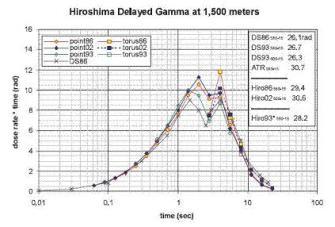
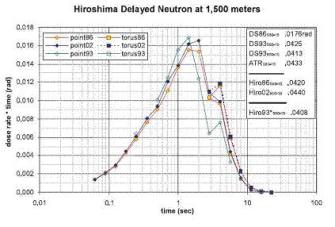
Figure 2 The radiation measured at 1.5 km from the Nagasaki Weapon. Shown on the left, x-rays/gamma rays, and on the right neutrons. The initial radiation coming from the bomb components is a short pulse, here about 5 seconds long.
Note that the scale is an unusual one of dose rate multiplied by time. Various different groups calculated the radiation from 1986, 1993, and 2002, and the agreement between them all can be seen.
Initial radiation at Hiroshima. The initial radiation from the Hiroshima weapon is shown in figure 3. The x-ray and the neutron dose both fall of extremely quickly.
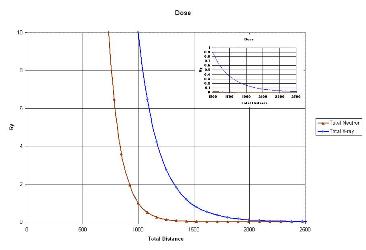
Figure 3 Initial radiation at Nagasaki. The initial radiation from the Hiroshima weapon is shown in figure. The x-ray and the neutron dose both fall of extremely quickly.
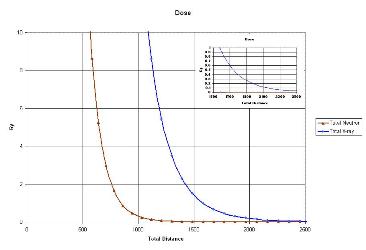
Figure 4 The initial radiation, falls into three main groups. At the closest ranges, 1km or less the dose is extremely high. The dose at this range is also where the blast and heat will be high as well, so the radiation dose will be only one of the problems. Radiation doses higher than 10Gy (1000 RAD) can be expected.
The intermediate range for the Nagasaki size device is around 1km to 1.5km. At this intermediate distance, the dose is falling off very rapidly, from 10Gray to 1 Gray. Part of that fall off is due to the “inverse square”, as the distance is doubled, the area irradiated goes up as the square, so the dose on each area is decreasing. Most of the effect is the air scattering and absorbing the radiation.
At this intermediate range, a few feet of earth that happen to be in the right place will make a large difference. Since air is around 1 kg for each cubic meter, radiation travelling through 500 meters of air has travelled through 500 kg of material. Water is about 1,000 kg per cubic meter so, 500 meters of air is about the same as half a meter (20 inches) of water.
At longer ranges, 2km or so, the initial dose is effectively minimal. At a distance of 2 km, the dose from a Nagasaki weapon is 14 RADS, at a distance of 2.5 km it is about 2.2 RAD. At Nagasaki, the initial radiation fell off to 1 RAD at 2770 meters.
In the intermediate distances sky shine can be an important consideration.
Sky shine is the scattering of the radiation from the air, and this means that’s some of the radiation is no longer coming directly from he source. An analogy would be a normal flashlight. In a dark room, most of the light from the flash light appears to mostly travel in a straight line. Some of that light is scattered off the walls and so some one can see things that are not just in the primary beam from the scattered light. If light wasn’t scattered off things, you would have top look directly into the flashlight to see anything.
In the radiation situation, some of the radiation is scattered in the air, and now the air around the event acts, like a source. The fast, initial radiation is redistributed.
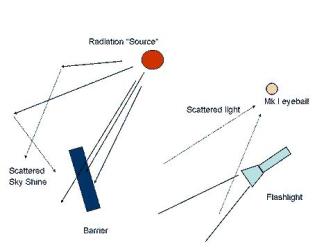
Figure 5 Sky shine radiation illustrated. On the right, light from a flashlight is scattered off the surroundings so an observer can see things with their Mark I eyeball. On the right, radiation from a source is scattered off the air, so the air glows faintly for a brief time and scattered radiation (sky shine) comes from all directions.
At long distances, the initial dose of radiation form the device falls off to essentially nothing. As an example, we can extrapolate the Nagasaki data. At a distance of 5km, the radiation dose is less than a micro RAD, and at 9km the dose is down to a pico RAD (a millionth of a millionth of a RAD).
III. Summary
The Hiroshima and Nagasaki weapon radiation is presented. The extremely rapid fall off in radiation is shown. After 2km the radiation dose is down to a negligible value.
IV. Appendix: Radiological Specifications of the Devices
Data taken from the Dosimetry System 2002 report
Little Boy Radiological Specifications:
Yield 16.5 =/- 1.5 kt.
Neutron activity: 0.1768 moles/kt
X ray activity: 0.006665 moles/kt
Total number of neutrons: 2.8512 (moles) = 1.72 x1024.
Total number x rays: 0.1099 (moles) = 6.62x1022.
Average neutron energy 310.6 keV.
Average x-ray energy 1398 keV
Fat Man Radiological Specifications:
Yield 20 =/- 2 kt.
Neutron activity 0.2640 moles/kt
X ray activity 0.09022 moles/kt
Total number of neutrons: 5.280 (moles) = 3.18 x1024.
Total number x rays: 1.804 (moles) = 1.087x1024.
Average neutron energy 12.6 keV.
Average x-ray energy 1267 keV
V. References and Further Reading
[DS02] Dosimetry System 2002 report on the Hiroshima and Nagasaki blasts
http://www.rerf.or.jp/shared/ds02/
[Brooking 2009] Image of a 155mm nuclear artillery mockup
http://www.3ad.com/history/cold.war/nuclear.pages/weapons.pages/m109.howitzer.htm
[FAS 2009] Federation of American Scientists
http://www.fas.org/man/dod-101/sys/land/m109.htm
[Wiki 2009] Wikipedia article
http://en.wikipedia.org/wiki/Nuclear_artillery
Radiological71
www.alpharubicon.com
All materials at this site not otherwise credited are Copyright © 1996 - 2009 Trip Williams. All rights reserved. May be reproduced for personal use only. Use of any material contained herein is subject to stated terms or written permission.